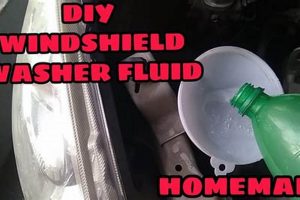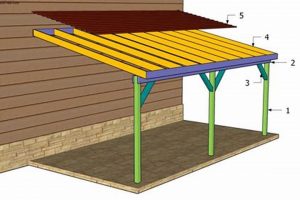Homemade alternatives to commercially produced dryer sheets offer a method for softening fabrics and reducing static cling during the machine drying process. These alternatives typically utilize readily available household ingredients and reusable cloths or materials, providing an option for consumers seeking to control the chemical composition of their laundry products and reduce waste. A common formulation involves soaking fabric scraps in a mixture of vinegar or fabric softener and essential oils before drying with clothes.
The significance of creating laundry aids lies in the potential for cost savings, reduced environmental impact, and customization of scents and ingredients. Pre-packaged dryer sheets often contain synthetic fragrances and chemicals that some individuals may find irritating or allergenic. The practice of creating one’s own sheets allows for the use of natural fragrances, such as essential oils, and the elimination of potentially harmful chemicals. Historically, line drying was the primary method for drying clothes, and advancements in technology, like the advent of the clothes dryer, led to the demand for products that would soften fabrics and reduce static in a machine-drying environment.
The following discussion will address specific recipes, techniques, and considerations for creating effective and environmentally conscious fabric softening solutions for use in clothes dryers.
Essential Considerations for Homemade Fabric Softening Solutions
The following guidance outlines best practices for creating and utilizing reusable fabric softening solutions. Adherence to these recommendations will maximize effectiveness and prolong the lifespan of both the dryer and the treated fabrics.
Tip 1: Fabric Selection is Crucial. Opt for highly absorbent materials such as cotton flannel or terry cloth for the base sheets. Superior absorbency ensures optimal delivery of softening agents throughout the drying cycle.
Tip 2: Dilution is Key to Prevent Residue. When using liquid fabric softener, dilute it significantly with water, aiming for a ratio of at least 1:4 (softener to water). Concentrated softener can leave a waxy buildup on clothing and within the dryer.
Tip 3: Essential Oil Usage Should Be Conservative. Introduce essential oils sparingly. Overuse can lead to overpowering scents that may linger on fabrics and potentially cause allergic reactions in sensitive individuals. Begin with just a few drops per batch of sheets.
Tip 4: Allow Complete Saturation Before Drying. Ensure that the chosen fabric sheets are thoroughly saturated with the softening solution before placing them in the dryer. Even distribution of the solution is paramount for consistent results.
Tip 5: Monitor Dryer Performance Regularly. Observe the dryer’s lint trap and interior for any signs of residue buildup. Clean the lint trap after each use and periodically wipe down the inside of the dryer drum with a damp cloth.
Tip 6: Avoid Overloading the Dryer. Overcrowding reduces the effectiveness of any fabric softening method, including these solutions. Smaller loads promote better air circulation and more uniform treatment.
Tip 7: Sun-Dry Periodically for Enhanced Freshness. Occasionally sun-drying clothes after machine drying can help to further eliminate lingering odors and refresh fabrics naturally.
Implementing these recommendations will promote a cost-effective, environmentally conscious, and personalized approach to fabric softening while preserving the integrity of both textiles and appliances.
The subsequent section will explore potential troubleshooting measures for common issues encountered while using these homemade solutions.
1. Material Absorbency
Material absorbency is a critical determinant of the efficacy of homemade fabric softener sheets. The capacity of the sheet material to retain and release the softening solution directly impacts the distribution of the treatment within the dryer, affecting the final outcome. Insufficient absorbency results in inadequate transfer of softening agents to the fabrics, leading to minimal softening and static reduction. Conversely, materials with high absorbency, such as cotton flannel or terry cloth, maximize the delivery of softening agents throughout the drying cycle, promoting uniform treatment and optimal results. The selection of an appropriate absorbent material is therefore fundamental to the success of any “diy fabric softener sheets” endeavor.
Real-life examples illustrate the significance of material absorbency. A trial using non-absorbent polyester scraps as fabric softener sheets yielded negligible improvements in fabric softness or static reduction. In contrast, identical mixtures applied to cotton flannel sheets significantly improved the tactile feel of dried clothing and noticeably reduced static cling. The practical implication of this understanding is that consumers should prioritize the use of highly absorbent natural materials when crafting their own fabric softener sheets to ensure optimal performance. Failure to do so renders the exercise largely ineffective, negating the intended benefits of homemade solutions.
In conclusion, the relationship between material absorbency and the effectiveness of the sheets is direct and substantial. The use of highly absorbent materials is essential for the effective delivery of softening agents and the achievement of desired results. Challenges such as sourcing cost-effective, absorbent materials can be mitigated through the reuse of old towels or flannel clothing. Understanding this core principle strengthens the practicality and viability of creating a sustainable and effective laundry solution.
2. Solution Concentration
The concentration of the softening solution used in homemade fabric softener sheets plays a pivotal role in the outcome of the drying process and the longevity of both the fabrics and the appliance. Precise control over solution concentration is essential to achieve the desired softening effect without causing unintended consequences.
- Optimal Softening
The primary objective is to achieve adequate softening without oversaturation. An appropriately diluted solution evenly coats the fabrics, reducing friction and static cling. Solutions that are too diluted may provide inadequate softening, rendering the process ineffective. A properly balanced concentration ensures the desired tactile improvements and static reduction are achieved.
- Residue Buildup
Excessive concentrations lead to residue buildup on the fabrics and within the dryer. This residue can manifest as a waxy coating, reducing the breathability of the fabric and diminishing its overall quality. In the dryer, residue accumulation can impede the machines efficiency and potentially damage heating elements
or sensors. Careful dilution minimizes this risk. - Scent Intensity
When using essential oils for fragrance, solution concentration directly influences scent intensity. Overly concentrated essential oils can create overpowering and potentially irritating aromas. Dilution allows for precise control over scent strength, creating a more pleasant and less intrusive olfactory experience. A measured approach is advisable, starting with minimal concentration and adjusting to preference.
- Textile Compatibility
Different fabrics respond differently to varying solution concentrations. Delicate fabrics, such as silk or linen, require more diluted solutions to prevent damage or discoloration. Sturdier fabrics, such as cotton or denim, can tolerate slightly higher concentrations. Consideration of textile composition is crucial to prevent adverse effects and maintain fabric integrity.
The meticulous management of solution concentration constitutes a cornerstone of successful sheets. Achieving the optimal balance ensures effective softening, minimizes residue buildup, regulates scent intensity, and maintains textile compatibility, thus ensuring the viability and long-term benefits of this sustainable laundry practice. Improper attention to this aspect will diminish the advantages and potentially cause irreversible damage.
3. Scent Customization
The ability to tailor fragrance profiles represents a significant advantage of crafting homemade alternatives to commercially produced dryer sheets. Scent customization allows for the elimination of synthetic fragrances, often implicated in allergic reactions, and the incorporation of natural essential oils to impart desired aromas. The following points detail key aspects of this practice.
- Selection of Essential Oils
The choice of essential oils directly determines the final fragrance profile. Lavender oil provides a calming scent, while lemon oil offers a refreshing aroma. Individual preferences and sensitivities should guide the selection process. Experimentation with single oils and blends allows for the creation of unique and personalized fragrances. The therapeutic properties of certain oils, such as eucalyptus for respiratory support, may also be considered.
- Concentration Control
The concentration of essential oils determines the intensity of the scent. Overuse can lead to overpowering aromas that may be unpleasant or irritating, especially for individuals with sensitivities. Starting with a low concentration and gradually increasing to the desired strength allows for precise control. The amount of essential oil required may vary depending on the potency of the oil and the absorbency of the sheet material.
- Blending Techniques
Combining multiple essential oils creates more complex and nuanced fragrance profiles. Understanding the relationships between different scents is crucial for successful blending. Citrus oils blend well with floral oils, while woody oils complement spice oils. Online resources and aromatherapy guides offer valuable information on scent pairings and blending techniques. Careful consideration of top, middle, and base notes ensures a balanced and harmonious fragrance.
- Allergen Considerations
Certain essential oils may trigger allergic reactions in sensitive individuals. Common allergens include tea tree oil, cinnamon oil, and peppermint oil. Thorough research and patch testing are essential before incorporating new oils into a homemade dryer sheet recipe. Providing clear ingredient lists for those using the dryer sheets is also a responsible practice. Alternative options, such as chamomile or vanilla, may be suitable for individuals with sensitivities.
The implementation of scent customization within “diy fabric softener sheets” underscores the adaptability and personal nature of this practice. By carefully selecting, controlling the concentration, and blending essential oils, consumers can create customized fragrance experiences that align with their individual preferences and sensitivities, while avoiding the potential adverse effects of synthetic fragrances. Furthermore, the mindful consideration of allergen concerns fosters a safer and more inclusive approach to homemade laundry solutions.
4. Dryer Compatibility
The operational longevity and efficiency of clothes dryers can be significantly affected by the materials introduced during the drying cycle. Therefore, careful consideration of dryer compatibility is paramount when utilizing homemade alternatives to commercial dryer sheets. Improper choices can lead to mechanical issues, reduced performance, or even appliance damage.
- Material Shedding
Certain materials used for constructing fabric softener sheets, particularly those that are loosely woven or prone to disintegration, can shed fibers within the dryer. These fibers accumulate in the lint trap and, more critically, within the dryer’s venting system. Clogged vents reduce airflow, causing the dryer to work harder, increasing energy consumption, and potentially creating a fire hazard. Regular cleaning of the lint trap and periodic inspection of the venting system are essential when employing homemade sheets.
- Residue Transfer
The softening agents used in homemade solutions can transfer onto the dryer drum and internal components. While diluted vinegar is generally considered safe, concentrated fabric softeners or oils may leave a residue. This residue can attract lint and debris, further impeding airflow and potentially damaging moisture sensors, which regulate the drying cycle. Regular cleaning of the dryer drum with a damp cloth is recommended to mitigate this risk.
- Flammability Concerns
Materials saturated with oils, particularly essential oils, pose a potential flammability risk if subjected to high heat. While the risk is generally low with proper dilution and moderate dryer temperatures, caution is advised. Avoid using highly flammable oils and ensure that the fabric softener sheets are not excessively saturated with solution. Monitoring the dryer during operation is a prudent safety measure.
- Sensor Interference
Modern dryers often employ moisture sensors to automatically determine when clothes are dry. Residue buildup from homemade fabric softener solutions can interfere with the accuracy of these sensors, causing the dryer to shut off prematurely or, conversely, to over-dry clothes. This not only affects drying efficiency but can also damage fabrics over time. Routine cleaning of the sensor bars is necessary to ensure accurate readings.
The interplay between dryer compatibility and the components of homemade alternatives underscores the importance of informed decision-making. While the potential benefits of creating dryer sheets are considerable, understanding and addressing these potential risks are essential for preserving appliance functionality and ensuring user safety. Diligence in material selection, solution preparation, and dryer maintenance are paramount for the successful and safe implementation of this practice.
5. Residue Prevention
The long-term viability of implementing homemade fabric softener sheets hinges critically on effective residue prevention strategies. Accumulation of residue from these solutions can negatively impact fabric quality, dryer efficiency, and overall appliance lifespan. Thus, proactive measures are essential to mitigate these adverse effects.
- Dilution Ratios of Softening Agents
The concentration of softening agents, such as vinegar or commercial fabric softeners, directly correlates with the potential for residue buildup. Employing overly concentrated solutions results in a higher deposition of these agents on fabrics during the drying process. The recommended approach involves adhering to precise dilution ratios, typically a minimum of 1:4 (softener to water), to minimize the risk of excessive residue accumulation. Consistent adherence to these guidelines maintains fabric breathability and avoids the stiffening effect associated with residue buildup. Real-world examples include the use of undiluted fabric softener, which resulted in significant wax-like deposits on clothing fibers after repeated drying cycles.
- Fabric Material Selection for Sheets
The choice of material used to construct the reusable fabric softener sheets influences the rate and extent of residue transfer. Materials that are excessively porous or prone to shedding, such as loosely woven cotton or synthetic blends, can exacerbate residue issues. Optimal materials are characterized by tight weaves and minimal shedding, such as cotton flannel or microfiber cloths. These materials minimize the transfer of fibers and excessive amounts of softening solution onto the clothing. The use of old, worn towels as an alternative has been observed to contribute to lint and residue problems in the dryer.
- Dryer Maintenance Protocols
Regular maintenance of the clothes dryer is crucial for preventing the accumulation of residue originating from homemade fabric softener sheets. This includes consistent cleaning of the lint trap after each drying cycle to remove loose fibers and particles that may have detached from the fabric sheets or clothing. Periodic wiping of the dryer drum with a damp cloth helps to remove residual softening agents that may have adhered to the surface. Failure to perform these maintenance tasks can lead to reduced drying efficiency and potential damage to the appliance’s heating elements or sensors. In professional laundry settings, neglected lint traps have been identified as primary contributors to dryer fires, highlighting the importance of consistent maintenance.
- Monitoring Fabric Condition
Regularly assessing the condition of fabrics dried with homemade softener sheets enables early detection of residue-related issues. Signs of residue buildup include a stiff or waxy texture, reduced absorbency, or a dull appearance. Upon detecting these symptoms, immediate action is required to rectify the situation. This may involve reducing the concentration of the softening solution, switching to a more suitable sheet material, or implementing a deep-cleaning cycle for affected garments using a mild detergent and vinegar rinse. Ignoring these warning signs can lead to irreversible damage to fabric fibers and a reduction in garment lifespan. A comparative analysis of garments dried with and without proper residue prevention measures has revealed a significant difference in fabric integrity over time.
The interconnectedness of these elements underscores the necessity of a comprehensive approach to residue prevention when employing these sheets. These best practices contribute to the sustainability of homemade laundry solutions and the longevity of both textiles and appliances.
Frequently Asked Questions about “DIY Fabric Softener Sheets”
This section addresses common inquiries and concerns regarding the creation and utilization of homemade alternatives to commercially available dryer sheets. The information presented aims to provide clarity and promote informed decision-making.
Question 1: What materials are best suited for constructing “diy fabric softener sheets?”
Optimal materials include tightly woven, highly absorbent fabrics such as cotton flannel or microfiber cloths. These materials effectively retain and distribute softening agents while minimizing shedding and residue transfer. Avoid loosely woven materials or those prone to disintegration.
Question 2: Is vinegar a safe and effective softening agent for “diy fabric softener sheets?”
Diluted white vinegar can serve as a safe and effective softening agent. It helps to reduce static cling and soften fabrics. However, it is essential to use vinegar in diluted form (typically a 1:4 ratio with water) to prevent potential damage to certain fabrics and to avoid a lingering vinegar odor. Some individuals may find the scent of vinegar objectionable, even when diluted.
Question 3: Can essential oils damage clothing or dryer components when used in “diy fabric softener sheets?”
While essential oils offer a natural alternative to synthetic fragrances, certain oils, if used in high concentrations, can potentially stain delicate fabrics or degrade rubber components within the dryer. It is advisable to use essential oils sparingly and to conduct a patch test on an inconspicuous area of fabric before widespread application. Always dilute essential oils with water or a carrier oil before applying them to the fabric sheets.
Question 4: How often should “diy fabric softener sheets” be replaced or replenished?
The lifespan of reusable fabric softener sheets depends on the frequency of use and the quality of the materials. Typically, the sheets should be replenished with the softening solution after each drying cycle or after a few cycles if the solution remains adequately saturated. The sheets themselves should be replaced when they begin to show signs of wear and tear, such as fraying edges or reduced absorbency.
Question 5: What are the potential environmental benefits of using “diy fabric softener sheets” compared to commercial dryer sheets?
The use of homemade alternatives can reduce reliance on single-use disposable dryer sheets, which contribute to landfill waste. The ability to customize ingredients also allows for the elimination of synthetic fragrances and potentially harmful chemicals found in commercial products. Reusing fabric scraps and utilizing natural softening agents further minimizes environmental impact.
Question 6: How can residue buildup from “diy fabric softener sheets” be effectively prevented and managed?
Preventing residue buildup involves adhering to proper dilution ratios for softening agents, selecting appropriate sheet materials, and implementing regular dryer maintenance protocols. Consistent cleaning of the lint trap and periodic wiping of the dryer drum are essential. Should residue buildup occur, a deep-cleaning cycle using a mild detergent and vinegar rinse can help to remove deposits from affected fabrics.
In summary, the successful implementation hinges on informed material selection, appropriate solution formulation, consistent maintenance, and an awareness of potential risks. Adherence to these guidelines promotes a sustainable and effective approach to fabric softening.
The subsequent section will provide information about potential alternatives for people who are allergic to some materials.
In Conclusion
This exploration of “diy fabric softener sheets” has underscored the nuances of creating effective, eco-conscious laundry aids. Crucial elements include careful material select
ion, precise control over solution concentration, thoughtful scent customization, thorough consideration of dryer compatibility, and diligent residue prevention strategies. The efficacy and safety of homemade alternatives depend on the conscientious application of these principles.
The insights presented serve as a foundation for informed decision-making. The responsible and well-considered adoption of these practices offers a tangible opportunity to minimize environmental impact, reduce exposure to potentially harmful chemicals, and exert greater control over the laundry process. Continued research and refinement will further optimize the benefits of this approach to fabric care.




![Diya Aur Baati Hum: Illuminate Your Home [DIY Guide] The DIY Hub: Creative Crafts, Repairs & Life Hacks Diya Aur Baati Hum: Illuminate Your Home [DIY Guide] | The DIY Hub: Creative Crafts, Repairs & Life Hacks](https://craftingdiycenter.com/wp-content/uploads/2025/07/th-5913-300x200.jpg)


